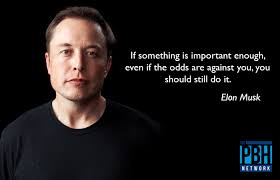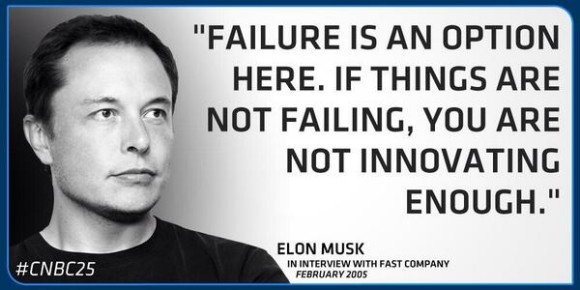This week, I will be working on an analysis of Elon Musk’s leadership style with an excellent team of individuals. While we’ve decided to approach the project from a different leadership theory, I can’t help but think of Musk after having learned the concepts of transformational leadership and think that looking at his leadership behaviors from this point will be a good exercise in preparing me for this project.
Musk’s leadership behaviors coincide with each of Bennis and Nanus’ four strategies typically used by transformational leaders (1985, in Northouse, 2013).
1. Vision: There is no doubt that Musk has a vision. He has a vision of a world that is no longer reliant on fossil fuels, is maximizing their use of green energy, and is exploring space and building colonies on Mars (Jacoby, 2011). This vision is attractive, simple, understandable, beneficial, and–quite literally–energy creating (Northouse, 2013, p. 197). Even though to most people his vision is neither realistic nor believable, Musk has made it his mission to make it both.

2. Social Architect: In many ways, Musk has inspired his employees. In each of his ventures–including the development of the Tesla Model S electric car and the launch of the SpaceX Falcon launch vehicle–Musk has managed to “mobile people to accept a new group identity [and] a new philosophy” (Northouse, 2013, p.197). For Musk, that philosophy is maintaining unprecedented standards of excellence and clearing unforeseen paths of progress in nearly abandoned industries. Dolly Singh recounts Musk’s address to his employees of SpaceX after the failure of the first launch attempt–a pivotal moment in which she recognized that “a failure in leadership would have destroyed us” (2013). However, in what Singh calls “the most impressive display of leadership that [she] had ever witnessed,” Musk encouraged and motivated his team with “fortitude and ferocity,” saying, “For my part, I will never give up and I mean never” (2013).

3. Trust: In this and similar situations, Musk continually earns the trust of his followers by “being predictable [and] reliable, even in situations that are uncertain” (Northouse, 2013, p.197). Time and again, when Tesla struggled through various crises of financial difficulty, Musk continued to fund the company out of his own pocket, ultimately investing over $100 million into the electric car company (Jacoby, 2011). It should be noted that research shows that transformational leadership is most effective in times of crises (PSU WC, 2015); as such, it is unsurprising that Musk’s transformational leadership strategies were most apparent in these uncertain situations.

4. Creative deployment of self: Northouse notes that transformational leaders have a high “positive self-regard” and focus on “their strengths rather than dwelling on their weaknesses” (2013, p. 197). Furthermore, they have a tendency to “immerse themselves in their tasks and the overarching goals of their organizations” (2013, p. 197). Musk is known for not being shy about his capabilities–he speaks openly about his ability to learn complex topics, including rocket science, through reading books (Jacoby, 2011). Additionally, to compensate for areas of weakness, he sources experts–recruiting professionals who are top in their field and relying on them to do the heavy lifting while still holding them to his standards of excellence in performance (Jacoby, 2011). Finally, in the way of immersion, Musk is known for sleeping very little and for throwing himself into projects with his team. For example, when Tesla was in need of funding, he spent 4 weeks on the ground with his team in an effort to fit his electric motor into a Smart car as a means of impressing the executives and ensuring their financial support (Jacoby, 2011).
In spite of all this, the strongest distinguishing factor between Musk and his vision and the standard transformational leader is the reliance on ethical standards, values, and moral convictions. Northouse speaks of one of the strengths of transformational leadership being its “strong emphasis on followers’ needs, values, and morals,” its attempt “to move people to higher standards of moral responsibility,” and its being “fundamentally morally uplifting” (2013, p. 201). In fact, it is this quality that allows for distinction between transformational leaders and pseudotransformational leaders, such as Adolf Hitler and Jim Jones, who rely on “coercive uses of power” to enact changes (2013, p. 201). As the saying goes, hindsight is 20/20; understanding of Musk’s leadership as having a moral quality or not will likely not be solidified until it is able to be analyzed as hindsight. Considering the magnitude and rate of change he is initiating in various industries, a strong argument could be on made both sides.
References
Jacoby, O. (Producer & Director). (2011) Bloomberg Risk Takers: Elon Musk [Television Broadcast]. United States: Bloomberg Television.
Northouse, P.G. (2013). Leadership: Theory and Practice. Los Angeles: Sage Publications.
Pennsylvania State University World Campus. (2015). PSYCH 485 Module 6: Contingency & Path-Goal Theories. Retrieved from https://psu.instructure.com/courses/1486679/modules/items/15963835
Singh, D. (2013) What is it like to work with Elon Musk? Quora. Retrieved from http://www.quora.com/What-is-it-like-to-work-with-Elon-Musk (Links to an external site.)


Elon Musk is an innovative, transformational leader that utilizes failure to fuel his organizations’ next round of effort. He’s not afraid to dream big, and he supports the dreams of his workforce. Your quote from Singh (2013) regarding a downturn in the business cycle “a failure in leadership would have destroyed us” really puts his leadership ability into perspective. Looking at the situation at that specific snapshot in time, I would say “wow, that’s real transformational leadership.” He effectively made adjustments to the discouraged status quo and appealed to his followers’ values while rebluing their collective sense of higher purpose. However, as you’ve discussed, it has taken more that just one successful attempt at motivation to keep the organizational dream alive. I believe that he has effectively recruited the right individuals to ensure continued organizational success.
A quick search for the career section of SpaceX, and you’ll find the following statement: “SpaceX was founded under the belief that a future where humanity is out exploring the stars is fundamentally more exciting than one where we are not; today SpaceX is actively developing the technologies to make this possible, with the ultimate goal of enabling human life on Mars” (SpaceX, 2015). A quick click on the Tesla “about us” and you’ll find: “Tesla’s mission is to accelerate the world’s transition to sustainable transport; Tesla is not just an automaker, but also a technology and design company with a focus on energy innovation” (Tesla, 2015).
His business model has attracted many like-minded individuals that enjoy the sexiness of being on the frontier of human limits. In addition to pure transformational ability, his followers create an organizational synergy that simply cannot fail.
References:
Singh, D. (2013) What is it like to work with Elon Musk?. Retrieved 29 March 2015
from: http://www.quora.com/What-is-it-like-to-work-with-Elon-Musk
SpaceX.com. (2015). Careers: Road to the Red Planet. Retrieved 29 March 2015 from:
http://www.spacex.com/careers
Tesla.com. (2015). About Tesla. Retrieved 29 March 2015 from:
http://www.teslamotors.com/about
As a very black and white person, I found your concise analysis of Elon Musk to be very helpful in understanding the somewhat fuzzy (at least to me) ideas surrounding Transformational Leadership. Your conclusion, in particular resonated with me. Despite the analysis of Musk using Bennis and Nanus’ four Transformational Leadership strategies of vision, social architect, trust and creative deployment, in the end, what is truly important is the leader’s “reliance on ethical standards, values, and moral convictions” (PSU Psych 485 Blog, 2014).
Northouse (2013) explained the conceptual father of transformational leadership, James MacGregor Burns, understood the difference between leadership and power to be that leadership could not be separated from the needs of the followers. My understanding therefore is: if you are leading, you must be concerned about the needs of the followers. Conversely, if to reach a goal, you are using power over people, you do not necessary concern yourself with the followers needs.
For me, Burns’ understanding puts the emphasis of leadership on morals and ethics. Starting with the leader attempting to facilitate change through engagement with others. The leader must accomplish this using what is considered moral or ethical from the standpoint of both the methods the leaders uses, and what the outcome is for the followers based on those methods.
Not only did you agree, along with Burns that the truly important factor in Transformational leadership is ethics, values and morals. But, for me it was especially eye opening when you pointed out that historical analysis of Musk would be needed to truly determine if his methods had a moral quality or not. I had not considered that before. When you think of the leaders of the past, it is easy to see what the outcome of their methods were on the followers. However, while in the process of using transformational leadership, one simply cannot predict the outcome.
References:
Northouse, P.G. (2013). Leadership Theory and Practice. Los Angeles: SAGE Publications, Inc.
Pennsylvania State University Psych 485 Blog (March 26, 2015) Elon Musk: Transformational Leadership in Action [Web log message]. Retrieved from http://sites.psu.edu/leadership/2015/03/26/elon-musk-transformational-leadership-in-action/